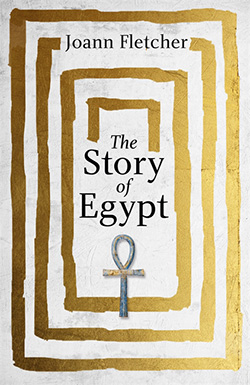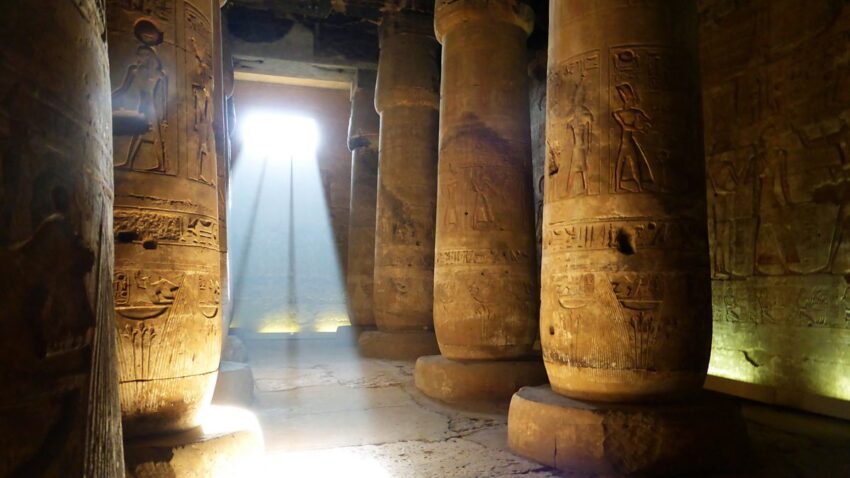 Joann Fletcher’s story of Egypt is a personal one. And she is a good storyteller. She writes expressively, making you hear the primordial Nile waters flooding and the evening fires in the desert crackling. Her story is inevitably a history of ancient Egypt, divided in the all too well-known kingdoms and dynasties, substituted by alliterative chapter names like ‘The Rule of Ra’ and ‘Zenith of the Sun’. It is prefaced by Egypt’s mythical beginnings, and traced to its actual source when the Sahara was still a savanna, 55,000 years ago.
Joann Fletcher’s story of Egypt is a personal one. And she is a good storyteller. She writes expressively, making you hear the primordial Nile waters flooding and the evening fires in the desert crackling. Her story is inevitably a history of ancient Egypt, divided in the all too well-known kingdoms and dynasties, substituted by alliterative chapter names like ‘The Rule of Ra’ and ‘Zenith of the Sun’. It is prefaced by Egypt’s mythical beginnings, and traced to its actual source when the Sahara was still a savanna, 55,000 years ago.
This story of Egypt is a personal story in that it subtly deals with Fletcher’s favorite subjects, such as the private lives of the kings and queens, with special attention to the female rulers of Egypt. Who has heard of Neithhotep and Merneith of the 1st Dynasty? Or knows Khentkaus I of the 4th Dynasty? All of these ladies probably ruled as kings, long before Hatshepsut did. The fact that female kingship is still hotly debated in Egyptology also speaks from Fletcher’s characterization of Sobeknefru as ‘the first female king whose status cannot be argued away, dismissed, played down or ignored’ (p. 150). The girl in question succeeded her brother Amenemhat IV as last ruler of the 12th Dynasty. And what of Ahhotep, the woman who became regent after Seqenre’s violent death? She was awarded a military decoration and buried with an arsenal of weapons.
Fletcher truly brings the characters in her book alive, albeit these are often royal characters in what appears to be the soap opera of ancient Egypt. In fact, so many names are mentioned that a non-Egyptologist might lose track. The 20 chapters that make up the book are concise, as a history encompassing 3000 years ought to be, and it is admirable that many figures are treated that would normally be left out. Likewise, some subjects that Egyptologists like to dwell on forever are merely touched upon (e.g. the Amarna period).
The book contains no numbered foot- or endnotes, but a list of quoted items in order of appearance per chapter at the back of the book, with a short reference that can be looked up in the bibliography. This is evidently done to prevent the flow of the narrative from breaking up, and although a high number of notes might scare off non-academic readers, it is rather tedious to have to look in two places each time in order to find out which scholar said what.
All in all, in compressing Egyptian history into a manageable whole, the book is an accomplishment. It reminds one of the narratives of old, by great names like Maspero, but updated with modern insights and presenting the latest discoveries. Inevitably, any history of ancient Egypt will be outdated in a number of years, but Fletcher is fair in stating that this is her version of the beloved story. That it focuses a lot on the lives of kings and queens may be taken for granted. Her down-to-earth tone with a hint of sarcasm can be heard in a phrase like the following (about Sesostris III): “…whose statues’ stern features are assumed to indicate a change in royal policy, and their large ears his ability to hear any plots against him – or he may simply have had large ears.” (p. 139)
From the building frenzy of Amenhotep III, the gallstones of Kha the builder, the military exploits of the Ramessides, and the hedonistic and murderous Ptolemies: Fletcher has a straightforward, warm and lively way of describing these ancient lives. In the accompanying documentary (Immortal Egypt, BBC2), she can be seen trotting around with her flaming red hair and signature parasol, like a present-day Amelia Peabody. The documentary does what the book unfortunately lacks a bit: presenting rich visual images. In it, she visits lesser known sites such as Qurta (with its prehistoric rock art), Mo’alla (housing the tomb of local governor Ankhtify) and the roof of the temple of Karnak. For good measure, she visits the tomb of Seti I the way we would all love to – without fellow tourists, flashlight in hand.
I hope that Joann Fletcher will continue to share with us her vision of ancient Egypt, in between academics and the greater public, both in writing and in her engaging appearance on screen.
